- ON THE DECADE
- THE DECADE'S CAMPAIGN
- REPORTING ON PROGRESS
- THE DECADE'S PROGRAMMES
- FOCUS AREAS
-
- Access to sanitation
- Financing water
- Gender and water
- Human right to water
- Integrated Water Resources Management
- Transboundary waters
- Water and cities
- Water and energy
- Water and food security
- Water and sustainable development
- Water and the green economy
- Water cooperation
- Water quality
- Water scarcity
- FOCUS REGIONS
- RESOURCES FOR
- UN e-RESOURCES
Water and the Green Economy
In a green economy there is emphasis on the pursuit of opportunities to invest in sectors that rely upon and use natural resources and ecosystem services. Investing in green sectors, including the water sector, more jobs and greater prosperity can be created. Arguably, these opportunities are strongest in areas where people still do not have access to clean water and adequate sanitation services. Early investment in the provision of these services appears to be a precondition for progress. Once made, the rate of progress will be faster and more sustainable, thus making transition to a green economy possible.
Water in the green economy focuses on the socio-economic opportunities that proper water management provides to social and economic development, whilst also safeguarding freshwater ecosystems. In green economies, the role of water in both maintaining biodiversity and ecosystem services and in providing water is recognised, valued and paid for.
Sources:
- Water on the road to Rio. UNW-DPAC, 2011
- Towards a Green Economy: Pathways to sustainable Development and Poverty Eradication (Chapter on Water). UNEP, 2011
The Green Economy and the MDGs
Crucial to the attainment of the Millennium Development Goals is the transition to a “green economy”, an economy that not only improves human well-being and lessens inequality but also reduces environmental risks and ecological scarcities.
| Links between ecosystem services and the Millennium Development Goals | ||
|---|---|---|
| Ecosystem services | Related MDG | Links with targets |
| Provisioning and regulating services | MDG1: Eradicate extreme poverty and hunger | Steady daily supplies of water, fuelwood and food can be improved with investments to sustain and ensure natural and cultivated ecosystems |
| Services from wetlands and forests | MDG3: Promote gender equality and empower women | Fuelwood and water: Improved availability would help gender equality as burden of provision falls mainly on women |
| Provisioning (medicinal plants) and regulating services (water) | MDG4: Reduce child mortality MDG5: Improve maternal health MDG6: Combat HIV/AIDS, malaria and other diseases |
Better availability of clean water and traditional medical supplies can create improved conditions for health |
Sources:
- A brief for policymakers on the Green Economy and Millennium Development Goals. UNEP, 2011
- Progress on Drinking Water and Sanitation 2012 update. JMP WHO/UNICEF, 2012
- Towards a Green Economy: Pathways to Sustainable Development and poverty Eradication (Chapter on Water). UNEP, 2011
What is a green economy...?
A Green Economy is an economy that results in improved human well-being and reduced inequalities over the long term, while not exposing future generations to significant environmental risks and ecological scarcities.
The Green Economy, water and…
- Agriculture: A green economy requires the achievement of food security, but by using less natural resources. This could be achieved through improved water management, substantial investments and innovations. It implies increasing crops that ensure a higher efficiency in terms of nutrition per drop of water.
- Cities: Compact cities reduce the spatial footprint of development and shared infrastructure reduces emissions and resource use. By harnessing the advantages of concentrated populations, cities can reduce dependency on transportation and infrastructure and provide basic services with greater efficiency.
- Ecosystems services: Recognizing the valuable, less visible and non-monetized benefits of conserving ecosystems represents an opportunity to recover sustainable growth, fairness, water security and poverty reduction paths while improving and protecting natural assets.
- Green jobs: In a green economy, growth in income and employment are driven by public and private investments that reduce carbon emissions and pollution, enhance energy and resource efficiency, and prevent the loss of biodiversity and ecosystem services.
- Industry: Industry can play a leading role in making water practices more sustainable by addressing overexploitation and contamination and improving water infrastructure and management. To reach these goals, industry must do “more with less”, ideally moving toward a goal of zero discharge.
- Water and Sanitation: In many developing countries, one of the biggest opportunities to expedite a transition to a green economy is to invest in the provision of water and sanitation services to the poor.
Sources:
- Information briefs on Water in the Green Economy. UNW-DPAC, 2011
- The transition to a Green Economy: Benefits, Challenges and risks from a sustainable Development Perspective. Report by a panel of experts to 2nd Preparatory Committee Meeting for the UN Conference on Sustainable Development. UNDESA, UNEP, UNCTAD, 2011
- Water in the transition to a green economy. UNEP, 2010
Transitioning to a green economy in water
Transitioning to a green economy in water requires a shift from current practice. Some key tools to promote the necessary change and support the transition are:
- Economic instruments. When properly designed and implemented, economic instruments are means to adapt individual decisions to desired policy goals;
- Green jobs. The transition to the green economy is an opportunity for the creation of decent jobs – those jobs where workers voices are taken into account and their rights are protected, including their access to social protection;
- Cost recovery and financing. The transition to a green economy requires mobilising more funds, but also increasing efficiencies to make better use of the limited financial resources available;
- Investments in biodiversity. Investing in natural capital is critical for restoring and sustaining the water-related services provided by ecosystems;
- Technology. Governments need to facilitate innovation and adoption of greener water provision and water use technologies, contributing to job creation and structural transformation towards greener economies;
- Water planning. Water planning is a powerful social tool for identifying the best way to use water resources to meet the competing needs of different users.
Source: Conference summary. Water in the green economy in practice. UNW-DPAC, 2011
Investments needed
To move toward a green growth, investments in different sectors are needed…
To ensure water efficiency: A saving of as much as 90% energy and 70% water can be achieved by investing in recovery and reuse of water - recycling industrial and municipal wastewater that can be used as industrial or cooling water.
- Agricultural water use accounts for about 75% of total global consumption; in many developing countries irrigation represents over 90% of water used. Globally, about 15-35% of irrigation withdrawals are considered unsustainable.
- Industry uses about 20% of global freshwater withdrawals: 57-69% for hydro and nuclear power generation, 30-40% for industrial processes and 0.5-3% for thermal power generation. Water used by industry is expected to reach about 24% of total freshwater withdrawal in 2025.
- In many fast-growing cities, wastewater infrastructure is non-existent, inadequate or outdated. Water storage, treatment and distribution systems are often poorly maintained. Moreover, in many countries of the developing world, water losses, due to technical leakage and water theft, often exceed 40-60% of the total water distribution.
To provide water access and sanitation services: Achieving a green economy is not possible without ensuring everyone has access to basic water and sanitation services. Across the world, access to these services has proved to be a critical step for lifting people out of the vicious cycle of poverty and environmental degradation.
- Investments in small scale projects that would provide access to safe water and basic sanitation could return in Africa an estimated overall economic gain of about $28.4 billion a year, or around 5% of GDP.
- The annual economic impact of inadequate sanitation is approximately US$ 6.3 billion in Indonesia, US$ 1.4 billion in the Philippines, US$ 780 million in Vietnam and US$ 450 million in Cambodia. In these four countries, the total value of this impact is US$ 8.9 billion per year.
Sources:
- Conference summary. Water in the green economy in practice. UNW-DPAC, 2011
- Millennium Ecosystem Assessment Ecosystems and Human Well Being (Synthesis). MA, 2008
- 3rd United Nations World Water Development Report: Water in a Changing World (WWDR-3). WWAP, 2009
- Towards a Green Economy: Pathways to sustainable Development and Poverty Eradication (Chapter on Water). UNEP, 2011
- Water in the transition to a green economy. UNEP, 2010
UN initiatives that are helping to raise the issue...
- 20-22 June 2012: Rio+20: United Nations Conference on Sustainable Development. Rio de Janeiro, Brazil
Rio+20 will mark the 20th anniversary of the 1992 United Nations Conference on Environment and Development (UNCED), in Rio de Janeiro, and the 10th anniversary of the 2002 World Summit on Sustainable Development (WSSD) in Johannesburg. The Conference focuses on two themes: (a) a green economy in the context of sustainable development poverty eradication; and (b) the institutional framework for sustainable development. Water is one of the seven priority areas for the conference. - 16 November 2011: UN-Water on the Road to Rio, water in the green economy for development and poverty eradication at the Bonn2011 Nexus Conference. Bonn, Germany
The UN-Water Decade Programme on Advocacy and communication (UNW-DPAC), in collaboration with the UN-Water Decade Programme on Capacity Building, organized a session at the Bonn2011 Nexus Conference which highlighted some key expectations that specific Member States have regarding water and the role of the UN in Rio+20 process. - 3-5 October 2011: International Conference on Water in the Green Economy in Practice: Towards Rio+20. Zaragoza, Spain
UNW-DPAC on behalf of UN-Water and in collaboration with OECD, ILO, the World Bank, UNEP, UNW-DPC, UNESCWA, UNECLAC and CHE, organized this conference to provide an opportunity to share examples of successful sustainable water management initiatives which deliver the so-called ‘triple bottom’ benefits for economies, people and the environment. During this conference, four main priority water-related issues were identified where change needs to take place in the transition to a green economy: agriculture, industry, cities and watersheds. Six tools were proposed to support the transition to a green economy: (1) economic instruments; (2) green jobs; (3) cost recovery and financing; (4) investments in biodiversity; (5) technology; and (6) water planning.
To know more...
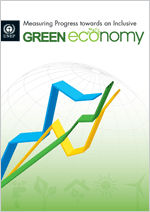 Measuring progress towards an inclusive green economy
Measuring progress towards an inclusive green economy
United Nations Environment Programme (UNEP). December 2012
This publication introduces a framework for the use of indicators in developing and tracking green economy policies. The objective is to provide guidance on the role of indicators in major stages of policymaking, using environmental issues as an illustrative entry point. Section 2 introduces the indicators for environmental issues and targets. Section 3 discusses indicators for environmental policy interventions. Section 4 focuses on indicators that show the impacts of policy interventions on well-being and social equity beyond the environmental realm. Examples of policies and the indicators that can be utilized to evaluate them are presented in Section 5. Data needs and capacity-building issues are highlighted in Section 6, and the final section points to the next steps that could facilitate the use of this framework.
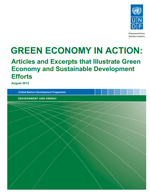 Green Economy in Action: Articles and Excerpts that Illustrate Green Economy and Sustainable Development Efforts
Green Economy in Action: Articles and Excerpts that Illustrate Green Economy and Sustainable Development Efforts
United Nations Development Programme (UNDP). August 2012
This review, selection and documentation of articles emerged in response to the need to fill the knowledge gap on practical, concrete, and on the ground green economy country experience. The articles and excerpts included in this publication have been selected: to provide information and knowledge for policy and decision makers and practitioners on the positive implications of greening some priority sectors, including job creation, resource efficiency, and generally contribution to sustainable development through an extensive review of scientific publications and magazines. Two cases on water are included: (1) Groundwater Pumping Leads to Sea Level Rise, Cancels out Effect of Dams; (2) Failing Water Infrastructure Drains Economy, Report Warns.
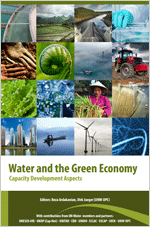 Water and the Green Economy. Capacity Development Aspects
Water and the Green Economy. Capacity Development Aspects
UN-Water Decade Programme on Capacity Development (UNW-DPC). May 2012
This publication gives special attention to the needs related to capacity development for water resources management, including water supply and sanitation, in the context of the green economy. This is done by showcasing theoretical and practical approaches which have proved to be successful. The 11 case studies in this book cover the entire range from innovative design and delivery of capacity development programmes related to water in the green economy, market mechanisms, and quality control procedures supporting capacity development success towards the practical implementation of programmes to enhance individual and institutional capacity.
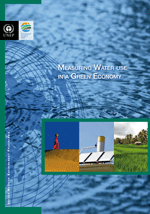 Measuring Water Use in a Green Economy
Measuring Water Use in a Green Economy
United Nations Environment Programme (UNEP). May 2012
This report analyses the different ways for quantifying and accounting for water flows and productivity within the economy (including environmental needs). Based on data from the literature, the report provides the current state of knowledge of the different indicators and tools for quantifying water productivity and highlights why this is important for developing robust allocation and management systems that preserve the natural capital. The report focuses on two main elements: 1) the conceptual background and knowledge on how water use puts pressure on the environment; 2) methodologies to quantify water availability and use and how this influences ecosystems.
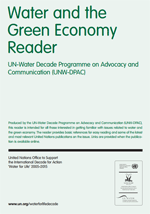 Reader on Water and the Green Economy
Reader on Water and the Green Economy
UN-Water Decade Programme on Advocacy and Communication (UNW-DPAC). 2011
This reader is intended for all those interested in getting familiar with issues related to water and the Green Economy. It provides basic references for easy reading and some of the latest and most relevant United Nations publications on this issue. Links are provided when the publication is available online.
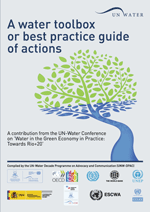 A water toolbox or best practice guide of actions [
A water toolbox or best practice guide of actions [ – 639.7 KB]
– 639.7 KB]
UN-Water Decade Programme on Advocacy and Communication (UNW-DPAC). 2011
As a contribution to the Rio+20 process, this water toolbox -or best practice guide of actions, instruments and policies- is an output from the international Conference held in Zaragoza from 3 to 5 October 2011. The objective of this document is to provide proposals based on the analysis of existing practice, reflecting specifically on lessons from implementation, scaling up and the relevance for developing and transition countries. The water toolbox proposes six tools which can be used to promote change and support the transition towards a green economy: (1) economic instruments; (2) sustainable financing; (3) investments in natural capital; (4) technology; (5) green jobs; and (6) water planning.
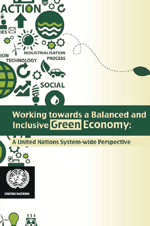 Working towards a Balanced and Inclusive Green Economy. A United Nations System-wide Perspective
Working towards a Balanced and Inclusive Green Economy. A United Nations System-wide Perspective
United Nations Environment Management Group (UNEMG). 2011
In September 2009, the United Nations Environment Management Group agreed to establish an Issue Management Group on Green Economy. This group was tasked to prepare a report to assess how the United Nations system could coherently support countries in transitioning to a green economy. The report is aimed at facilitating a common understanding of the green economy approach and the measures required for the transition.
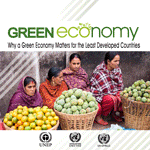 Why a Green Economy matters for the Least Developed Countries [
Why a Green Economy matters for the Least Developed Countries [ – 1.46 MB]
– 1.46 MB]
United Nations Environment Programme (UNEP), United Nations Conference on Trade and Development (UNCTAD), United Nations Office of the High Representative for the Least Developed Countries, Landlocked Developing Countries and Small Island Developing States (UN-OHRLLS). 2011
This joint report points to the economic and human development opportunities of a green economy transition for the world’s least developed countries (LDCs). It aims to be illustrative rather than comprehensive by showcasing examples of innovative policies and practices, identifying emerging opportunities and challenges for a green economy transition in LDCs, and stimulating further discussion amongst interested stakeholders.
 The Transition to a Green Economy: Benefits, Challenges and Risks from a Sustainable Development Perspective. Report by a Panel of Experts to 2nd Preparatory Committee for UNCSD
The Transition to a Green Economy: Benefits, Challenges and Risks from a Sustainable Development Perspective. Report by a Panel of Experts to 2nd Preparatory Committee for UNCSD
[ – 0.98 MB]
– 0.98 MB]
United Nations Department of Economic and Social Affairs (UNDESA), United Nations Environment Programme (UNEP), United Nations Conference on Trade and Development (UNCTAD). 2011
This publication contains three different papers. The first paper addresses the macroeconomic policy implications of the transition to the green economy; the second sheds light on the interlinked issues of trade, investment and technology; the third highlights the risks that this concept generates for developing countries and the domestic and international policies necessary to promote the green economy in these countries according to the principles of sustainable development. This summary presents the major policy conclusions derived from these contributions. The issues of financing and technology development, transfer and cooperation are particularly highlighted by this report. The chapter on “Challenges of the green economy concept and policies in the context of sustainable development, poverty and equity” describes the risks of misusing the green economy concept as well as policies and measures for promoting sustainable development and green economy. The critical role of water is highlighted through different examples.
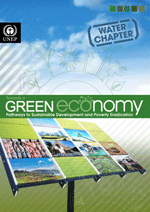 Towards a Green Economy: Pathways to Sustainable Development and Poverty Eradication. Water Chapter
Towards a Green Economy: Pathways to Sustainable Development and Poverty Eradication. Water Chapter
[ – 4.62 MB]
– 4.62 MB]
United Nations Environment Programme (UNEP). 2011
This report elaborates on particular reforms needed to unlock the productive and employment potential of a green economy. The water chapter, called “Water: investing in natural capital”, has three broad aims. First, it highlights the importance of providing all households with sufficient and affordable access to clean water supplies as well as adequate sanitation. Second, it insists on early investments in water management and infrastructure, including ecological infrastructure. Third, the chapter provides guidance on the suite of governance arrangements and policy reforms, which, if implemented, can sustain and increase the benefits associated with making a transition to the green economy.
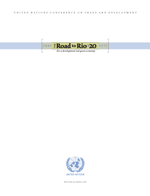 The Road to Rio+20. For a development-led green economy
The Road to Rio+20. For a development-led green economy
[ – 9.47 MB]
– 9.47 MB]
United Nations Conference on Trade and Development (UNCTAD). 2011
This publication contributes to the debate on the Green Economy through a collection of essays that provide different perspectives on how to increase the benefits and reduce risks associated with the transition to a development-led green economy. The report also assesses potential measures for achieving the green economy and the sectors, including the water sector, where these measures might be particularly important.
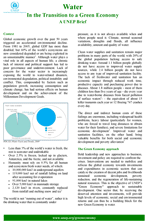 Water in the Transition to a Green Economy. A UNEP Brief
Water in the Transition to a Green Economy. A UNEP Brief
[ – 211 KB]
– 211 KB]
United Nations Environment Programme (UNEP). 2010
The aim of this brief is to introduce the objective of UNEP’s Green Economy approach to sustainable development. This approach sheds light on the need for interventions that mobilize and refocus the global economy towards investments and expenditures in economic sectors that can catalyze the creation of decent jobs and livelihoods, sustained economic development, poverty reduction, and the regeneration of life-sustaining natural resources.
Green Economy around the world
Arab Countries
 Green Financing for the Arab Region. Background Paper
Green Financing for the Arab Region. Background Paper
[ – 127.8 KB]
– 127.8 KB]
United Nations Economic and Social Commission for Western Asia (UNESCWA). 2011
This background paper reviews the concept of green finance using the case of the Arab region. It analyzes the role of the public financial sector in Arab countries in reforming economic policies in order to facilitate the channeling of capital and stimulate a fair, advantageous and timely transition to a green economy in the region.
Africa
 Growing Greener Cities. First status report on urban and peri-urban horticulture in Africa
Growing Greener Cities. First status report on urban and peri-urban horticulture in Africa
Food and Agriculture Organization of the United Nations (FAO). August 2012
This report draws the attention of policymakers to urban and peri-urban horticulture (UPH), and how it can help to grow greener cities in Africa. Based on an Africa-wide survey and on case studies prepared by national experts, the report reviews the current state of UPH in countries across the continent, from Algeria to Zambia, and in cities from Nairobi to Dakar. It presents major findings, detailed profiles of urban and peri-urban horticulture in 22 countries and recommendations for the development of market gardens to serve Africa's rapidly growing urban population. Issues such as access to water and sanitation or irrigation practices are covered in the report.
Asia and the Pacific
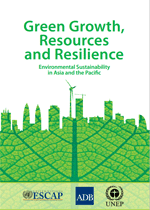 Green Growth, Resources and Resilience. Environmental Sustainability in Asia and the Pacific
Green Growth, Resources and Resilience. Environmental Sustainability in Asia and the Pacific
United Nations Environment Programme (UNEP), Economic and Social Commission for Asia and the Pacific (ESCAP), Asian Development Bank (ADB). 2012
This report has been produced to support policymakers and stakeholders in a changing development context, 20 years after the 1992 Earth Summit. It provides a closer look at resource use trends and at green growth strategies in response to the mounting challenges to sustainable development and in support of a transition towards green economies in the Asian and Pacific region.
Europe
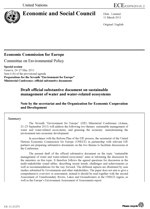 Draft official substantive document on sustainable management of water and water-related ecosystems [
Draft official substantive document on sustainable management of water and water-related ecosystems [ – 148 KB]
– 148 KB]
Economic Commission for Europe (UNECE), Organization for Economic Cooperation and Development (OECD). March 2011
The 7th Environment for Europe Ministerial Conference (Astana, 21-23 September 2011) addressed the following two themes: ‘Sustainable management of water and water-related ecosystems’, and ‘Greening the economy: mainstreaming the environment into economic development’. This draft of the official substantive document on the topic ‘Sustainable management of water and water-related ecosystems’ aims to inform the ministerial discussion on this topic. It therefore follows the agreed questions for discussion in the multi-stakeholder round tables, describing recent trends, challenges and achievements as well as recommendations for the way forward. The different themes are illustrated by case studies submitted by governments and other stakeholders.
Latin America and the Caribbean
 Sustainable Development 20 Years on from the Earth Summit. Progress, gaps and strategic guidelines for Latin America and the Caribbean
Sustainable Development 20 Years on from the Earth Summit. Progress, gaps and strategic guidelines for Latin America and the Caribbean
Economic Commission for Latin America and the Caribbean (UNECLAC). February 2012
This document presents an analysis of progress made and difficulties encountered in Latin America and the Caribbean in implementing global commitments on sustainable development since 1992 and proposes a series of guidelines for moving towards sustainable development in the region.

"In the next twenty years, the world will need at least 50 per cent more food, 45 per cent more energy, 30 per cent more water and many millions of new jobs. Our challenge at Rio+20 and beyond is to take a holistic, integrated approach to these linked challenges driving at the interrelations such that solutions to one problem translate into progress on all."
UN Secretary General
Ban Ki-moon on the occasion of International Mother Day, 22 April 2012

"Our common efforts should lead to building green societies based on a global culture of sustainability and the efficient management of our scarce water resources. Measuring our ecological footprint is an indispensable foundation of green societies, upon which the green economy must be based."
Ms Gretchen Kalonji. Assistant Director-General for Natural Sciences
United Nations Educational, Scientific and Cultural Organization (UNESCO)
>> Water and agriculture in the Green Economy
[ - 236 KB]
- 236 KB]
>> Water and Cities in the Green Economy
[ - 209 KB]
- 209 KB]
>> Water and Industry in the Green Economy [ - 202 KB]
- 202 KB]
>> Watersheds and aquifers in the Green Economy [ - 180 KB]
- 180 KB]
>> Water Financing in the Transition to the Green Economy
[ - 105 KB]
- 105 KB]
>> Water and Capacity Development in the Transition to the Green Economy [ - 186 KB]
- 186 KB]
>> Water and Technology in the Transition to the Green Economy [ - 201 KB]
- 201 KB]

>> Julia Bucknall
Manager of the World Bank’s central unit for water
"For me, the green economy means thinking hard about making sure that the actions of today will not lock us into problems tomorrow. Also, it means thinking hard about ways in which we can meet the needs of the poor and the needs of poor countries"
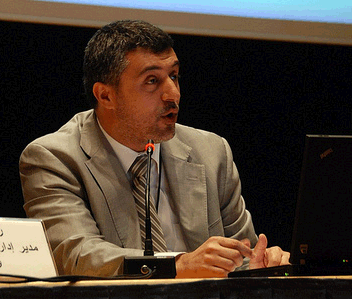
>> Mohamed Al-Hamdi
First Economic Affairs Officer in the Water Resources Section the Sustainable Development and Productivity Division of ESCWA.
"I am sure that there are many good messages that have been raised during the preparatory process towards Rio+20, but I believe that a message of equity is one that many will support"
>> More interviews on water and the green economy
>> UN-Water Conference ‘Water in the Green Economy in practice: towards Rio+20’
UNW-DPAC
Video recording of sessions of the International UN-Water Conference ‘Water in the Green Economy in Practice: Towards Rio+20’ which took place in Zaragoza, Spain, from 3 to 5 October 2011.
>> Brazil: Grey Water, Green Ground
IFAD
Place: Brazil
May 2012
Duration: 3min13sec
In the North East of Brazil, millions of people battle to grow food around their houses due to toxic grey water from washing and sewage that runs outside. But now a newly designed biowater filtering system has the potential to change all of their lives. The dirty water passes through a filtering system. The filtered water is then clean enough to use to irrigate the land. This is the story of Ulisses dos Santos who has tested out the system for one year. Now he is not only eating better, but also making a profit.
Copyright | Terms of use | Privacy notice | Site Index | Fraud alert | Help




